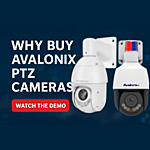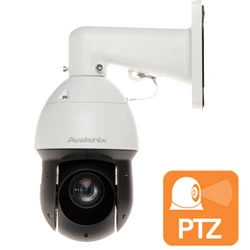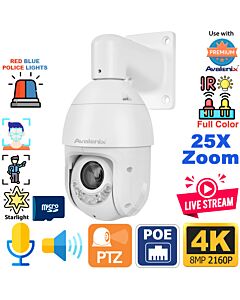Pan-Tilt-Zoom Security Cameras
Cameras with Unparalleled Control
PTZ cameras are the swiss army knife of security and provide unmatched flexibility in warehouses. Pair them with fixed lens cameras for a comprehensive system.
Browse
If you’ve been shopping for a PTZ (Pan-Tilt-Zoom) camera, you’ve probably noticed that the market is crowded with options. From cheap imports on Amazon to professional-grade systems, the range in price and quality can be confusing. The question most buyers ask themselves is: what’s worth my money? That’s where Avalonix Premium Series PTZ cameras come in. In this guide and video, we’ll explore why investing in an Avalonix PTZ makes sense for anyone who values clear video, reliable performance, and long-term durability.
Explore our full PTZ category here:

Pan-Tilt-Zoom Security Cameras
Cameras with Unparalleled Control
PTZ cameras are the swiss army knife of security and provide unmatched flexibility in warehouses. Pair them with fixed lens cameras for a comprehensive system.
BrowseFeatured Cameras in this Video:

Words can describe, but video shows. Watch the unedited live demo below to see how our PTZ cameras perform in real-world conditions — daytime clarity, nighttime accuracy, optical zoom, and smart analytics that go beyond what cheaper cameras can do.

Most PTZ buyers are looking for three things: reliability, image quality, and versatility. Think of it like buying a car: you don’t want one that looks flashy on the lot but breaks down after six months. You want something that can handle daily use, whether you’re commuting to work or taking a road trip. In the same way, a PTZ camera needs to withstand weather, provide smooth zoom, and keep delivering crisp footage year after year.
Avalonix PTZ cameras are engineered with reliability in mind. Unlike budget cameras that often wear out when motors are overused, these cameras are designed for years of smooth pan, tilt, and zoom movement. Outdoor models are IP-rated for weather resistance, meaning they stand up to rain, dust, and freezing temperatures. In other words, they’re built for the real world, not just a spec sheet.
The video demo shows how Avalonix PTZs handle zoom. Optical zoom is like moving closer with a professional camera lens — detail stays crisp. Digital zoom is like enlarging a photo on your phone: useful, but limited by the original image quality. Avalonix models pair generous optical zoom ranges (up to 40x on some models) with digital zoom to give you flexibility both live and during playback. That means you can zoom in to read license plates or facial details without the pixelation that plagues low-end PTZs.
Motion blur is one of the biggest complaints we hear from customers who tried bargain PTZ cameras. Cars look smeared, faces become unrecognizable, and fast-moving objects vanish into streaks. Avalonix PTZ cameras, on the other hand, record at a full 30 frames per second, even at higher resolutions like 2K and 4K. The difference is like watching sports on a cheap TV versus a high-end one — one leaves you guessing, the other keeps up with every detail.
Daytime performance is impressive, but night video separates professionals from pretenders. Many cameras look sharp at noon but fail completely under streetlights. Avalonix PTZs use advanced sensors that minimize motion blur even when vehicles are moving at 40 mph at night. With the right ambient lighting, these cameras retain color detail far better than typical consumer models. It’s the difference between identifying a suspicious truck in your lot versus just knowing something drove by.
Motion blur is a physics and settings problem, not a mystery. Four variables drive it in security video: available illumination, the camera’s image sensor and processing, the frame rate you record at, and whether you are using an analog DVR system or a modern IP camera + NVR system.
Low light forces longer exposure times, which smear moving subjects. At night, if the scene is dim and you force a camera to stay in color, the shutter may hover around 1/15–1/30 second to keep the image bright. A vehicle going 40 mph travels ~58.7 ft/sec; at 1/30 sec exposure that’s almost 2 ft of motion during a single frame, which shows up as blur on plates and fine detail. Give the camera more light and it can expose faster, which reduces the smear.
Better sensors gather more light per frame and reduce noise more cleanly, which lets the camera hold shorter exposures without turning the image into mush. That is one of the core differences you see in our Avalonix PTZ line compared to budget gear. A stronger sensor pipeline means more detail at the same frame rate, especially in marginal lighting.
Higher frame rates give you more “slices” of the action and reduce the distance a subject moves between frames. Our IP cameras provide a high-FPS digital video stream to the NVR, and you can record at a true 30 fps for smoother, cleaner motion capture. By contrast, analog DVR systems often throttle at higher resolutions; 4K analog commonly tops out around ~7 fps and 5MP analog around ~12 fps, which increases perceived blur and makes fast subjects jumpier in playback.
Analog at 4K/5MP sacrifices frame rate to push pixels through legacy transport, so you trade motion clarity for resolution. An IP camera streams compressed digital video directly to the NVR at full frame rate, so you get both resolution and motion fidelity. In practice, 30 fps IP at night with some ambient light will outperform a higher-resolution analog stream running at a fractional frame rate.
If you force an IP camera to stay in color mode with low ambient light, you will still see blur on fast-moving objects. That is expected physics. The cure is simple: provide ambient white light so the camera can hold a faster shutter, or let the camera switch to black-and-white where it leverages IR for shorter exposures and crisper edges. In our video on this page, cars exceeding ~35 mph showed some blur because the exterior lighting around the building kept the camera in color mode; the camera prioritized color retention over a very fast shutter.
If your requirement is color identification of fast-moving vehicles at night, pair the optics with lighting. A proven option is our Active Deterrence 4K PTZ with a built-in white-light LED. The added illumination helps hold faster shutter times, reduces motion blur, and preserves vehicle color up to roughly 40 mph in many real-world scenes.

4K PTZ Camera with Active Deterrence
Survey your property in color and 25X Optical Zoom
Browse 4K PTZAnother reason Avalonix PTZs stand out is their built-in analytics. They don’t just record everything; they make sense of it. With features like intrusion zones, human and vehicle detection, and optional auto-tracking on certain models, you can cut down on false alarms and focus on what really matters. Think of it as hiring a security guard who never blinks — the camera filters out irrelevant motion, like a swaying tree, and alerts you only when a person or car enters the frame.
Where do these cameras shine? A few examples:
Cheap PTZs might tempt you with low prices, but when you need clear footage of a license plate, a face, or an incident at night, you’ll wish you invested in a camera that delivers. Avalonix Premium Series PTZs are built to do exactly that. They offer the optics, frame rates, and intelligence that make surveillance actionable rather than just decorative. Whether you’re protecting property or streaming a scenic view, Avalonix PTZs deliver long-term value, not frustration.